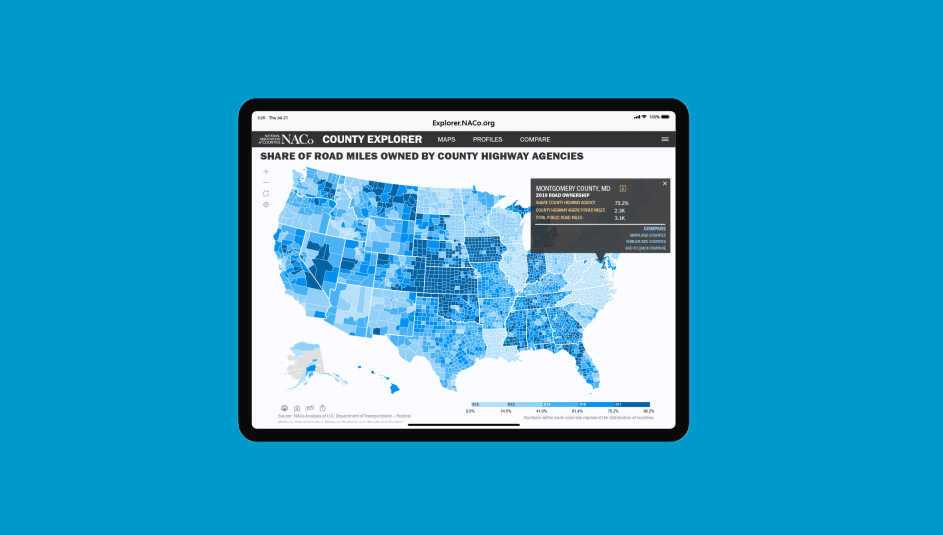Economic Mobility Resource Hub

Upcoming Events
Related News
Explore these resources to promote inclusive economic prosperity for county residents. Counties may want to start with the three tools developed for local decision makers by NACo’s partners at Results for America, the Urban Institute and Opportunity Insights.
Additional selected resources provide targeted solutions in seven key policy areas, including housing, education and workforce development, financial security, health, community and neighborhood development, justice and public safety, and technology and information. Look for the Rural County icon for resources especially helpful for rural communities.
About this Tool
Explore these resources to promote inclusive economic prosperity for county residents. Counties may want to start with the three tools developed for local decision makers by NACo’s partners at Results for America, the Urban Institute and Opportunity Insights.
Additional selected resources provide targeted solutions in seven key policy areas, including housing, education and workforce development, financial security, health, community and neighborhood development, justice and public safety, and technology and information. Look for the Rural County icon for resources especially helpful for rural communities.
Jump to Section
Featured Partner Resources
Opportunity Insights Opportunity Atlas
The Opportunity Atlas maps neighborhoods where children have the best opportunity to achieve greater economic prosperity as compared to their parents. This analysis helps counties develop programs that target census tracts and communities where opportunity is lacking.
Urban Institute Upward Mobility Framework
The Urban Institute’s Upward Mobility Framework identifies validated performance indicators that county leaders can use to set baselines and measure progress on policies and programs intended to boost upward mobility and narrow racial inequities. The indicators are organized into five categories: opportunity-rich and inclusive neighborhoods, high-quality education, rewarding work, healthy environment and access to good health care, and responsive and just governance.
Results for America Economic Mobility Catalog
Results for America’s Economic Mobility Catalog provides examples of evidence-based strategies, practices and programs designed to improve outcomes that drive upward economic mobility for individuals, families and communities.
Economic Mobility in Action
Boone County, Mo. Brings Community into Economic Mobility Decision Making
Commissioner Janet Thompson and Verna Laboy, Program Manager for Upward Mobility share how the Urban Institute's data metrics dashboard and planning guide helped them to engage their community at the start of the planning process to design inclusive strategies for upward economic mobility.
County-Level Data
These resources support counties in making data informed decisions with hundreds of data points to browse.
County Explorer
NACo's County Explorer tool is the one-stop shop for accessing county-level demographic, economic and policy data profiles and comparisons.

Urban Institute: Mobility Metrics
These mobility metrics measure progress toward increasing economic prosperity in every county. The Urban Institute's Upward Mobility Framework identifies five policy pathways out of poverty and a set of evidence-based measures to create conditions that boost the economic and social well-being of its residents.
Distressed Communities Index
The Distressed Communities Index geographically measures economic well-being within and between counties.
Smart Growth Self-Assessment for Rural Communities
The U.S. Environmental Protection Agency provides a process and check list for rural communities to conduct a self assessment of existing codes, policies and programs to meet local goals to create healthy, environmentally resilient and economically robust places. The tool includes links to examples and resources for communities that want to work towards implementing new approaches based on assessment results.
Headwater Economics: Rural Capacity Map
Headwater Economics developed the Rural Capacity Index to identify communities with gaps in the staffing and expertise needed to successfully apply for federal funding for infrastructure, climate resilience and community development projects. The 10 capacity indicators are mapped at the county level across the U.S.
Understanding Economic Mobility
In the United States, economic mobility centers around the ideal that each generation can do better than the last. County leaders are uniquely positioned as economic mobility changemakers through their authorities, policies, service delivery and funding.
County Levers to Drive Economic Mobility: Local Solutions and Strategies
NACo’s County Levers report defines the role, authority and opportunity for counties to affect economic outcomes for residents. It provides county case examples in seven policy areas that drive economic mobility: housing, education and workforce development, health, community and neighborhood development, justice and public safety, technology and information access and financial security.

County Levers Webinar
NACo’s webinar highlights county leaders in Franklin County, Ohio and Waukesha County, Wis. who applied the guidance from NACo's County Levers to Drive Economic Mobility report to address county housing and workforce development needs.
County Two-Generation Strategies for Family Wellbeing
This webinar discusses county implementation of a two-generation (child and parent focused) approach to human services and education in counties in Arapahoe County, Colo.; Franklin County, Ohio; Montgomery County, Md.; and Onondaga County, N.Y.
Opportunity Insights
Opportunity Insights provides foundational research, data and trends on the state of economic mobility at the local level and shares policy solutions to promote upward mobility for all.
Rural Dreams: Upward mobility in America’s countryside
This Brookings Institution report can help county leaders from rural areas understand how migration, K-12 education, family stability, health care, economic opportunity and race play a role in upward mobility.
Housing
In the United States, economic mobility centers around the ideal that each generation can do better than the last. County leaders are uniquely positioned as economic mobility changemakers through their authorities, policies, service delivery and funding.
NACo Housing Task Force Recommendations
Chartered by past NACo President Denise Winfrey, this toolkit identifies five areas where all counties can foster housing affordability: Land use and infrastructure; regulation, codes and fees; federal-county nexus; community engagement; and finance.

Housing Solutions Matchmaker Tool
This tool characterizes counties by the affordability, quality and supply of the housing stock and shares policy solutions and recommendations based on an individual county's housing profile.
Housing America’s Residents: The Role of Counties
This report defines the county role and authority in tackling America’s nationwide housing shortage, illustrating opportunities for county action.
Housing for the Justice-Involved: The Case for County Action
Explore administrative and legislative measures county leaders can take to build an effective housing program for formally incarcerated individuals re-entering society.
Local Strategies for Reaching Families and Young Children Experiencing Homelessness
NACo’s webinar features examples of county successes in addressing early childhood homelessness and informing local leaders on how to reduce barriers and increase families’ connections to health and early learning programs.
HUD Case Studies
The U.S. Department of Housing and Urban Development provides case studies on strategies for increasing sustainable affordable housing and accessible public transportation. Examples include approaches for senior housing, anchor institutions, supportive housing and zoning.
Education and Workforce Development
Education and workforce development programs increase county residents’ knowledge and skills to prepare them for better employment opportunities. This programming is critical for improving intragenerational economic mobility and supporting workers in low-wage occupations and those displaced from the labor market due to skills or credentials mismatch with available job openings.
Advancing Economic Mobility through Community College Partnerships for Workforce Development
NACo and NLC’s joint webinar demonstrates how community college and county leaders partner to address local challenges such as bachelor’s degree completion time, student retention, student debt reduction and the advancement of skills-based hiring.

Counties Can Improve Economic Mobility Through Adult Literacy
NACo’s webinar explains the connection between adult literacy rates and economic mobility and explores multisector approaches county leaders are taking to address adult literacy.
USDA Resource Guide for Rural Workforce Development
The USDA Resource Guide outlines programs and resources from USDA and other federal agencies that build a stronger workforce in rural communities through workforce development planning; infrastructure and equipment financing; industry and employer engagement; entrepreneurship and local business development; and education, training and apprenticeship.
Pre-K for All: Improving and expanding pre-K programming through outcomes-based funding
This case study outlines how the City of Memphis and Shelby County, Tenn. established universal needs-based pre-K programming to address inequities in access to high-quality early childhood education. Strategies included multi-sector and intergovernmental partnerships, a joint city/county ordinance, clear reporting structure and data sharing practices, goals and success metric alignment and an outcomes-based funding model.
Financial Security
About half of Americans live paycheck-to-paycheck and lack stability when the status of their housing, employment or health changes. Counties can support their residents in attaining the three pillars of financial security: routinely positive cash flow, personal resources and public and private benefits.
The County Human Services and Education Landscape
NACo’s toolkit outlines the role of the county in funding and administering core public benefits programs across federal agencies, including public education, children and families supports, aging and disability services, food and nutrition assistance and veterans services.

Solving the Consumer Debt Crisis: An Action Guide for Local Government
The Aspen Institute Financial Security Program identifies ways counties can pursue tailored solutions to help mitigate the effects of consumer debt. Areas for county action include access to high-quality credit; delinquency, default and collections practices; government fines and fees; and student loan burden.
Health
Health plays a key role in individuals’ economic outcomes. Poor health can prevent residents from earning a stable income, negatively affect educational outcomes and cut into household budgets. By effectively addressing public health priorities, counties can also advance economic mobility goals.
Opioid Solutions Center
NACo's Opioid Solutions Center provides up-to-date resources, technical assistance, key data and county examples for approved use of opioid settlement funds with a focus on effective treatment, recovery, prevention and harm reduction practices that save lives and address the underlying causes of substance use disorder.

Addressing Housing to Improve Health Outcomes
NACo’s report provides strategies to address housing equity and improve health outcomes through partnerships, housing affordability, eviction prevention, housing quality and safety, neighborhood safety and proximity to amenities.
The County Role in Ending Homelessness and Improving Public Health
NACo’s report shares how homelessness can exacerbate or directly cause adverse health conditions through barriers to accessing health care, nutritious food and safety and social services. By leveraging partnerships and data, counties can solve homelessness and public health problems in both the short and long run.
Map The Meal Gap Interactive Map
This Feeding America resource equips local leaders with a high-level evaluation of their food insecurity challenges, measured for both children and the overall population in every county, congressional district and state and service area within Feeding America’s nationwide network of food banks. This data allows county leaders to benchmark their local communities and measure progress over time.
Case Study: King County, Washington
Results for America summarizes how King County, Wash. took a data-and-evidence-driven approach to improving the funding flexibility, outcomes focus and government-provider feedback in the health and human services providers contracting process. This turnkey model for optimizing service delivery allows counties to address public health challenges more efficiently, with more flexibility and with reduced overhead.
County Health Rankings & Roadmaps
Developed by the University of Wisconsin Population Health Institute, this website provides health and quality-of-life data and resources to help county leaders understand root causes of challenges and opportunities that affect community health equity through targeted strategy development and partnerships.
Community and Neighborhood Development
Key aspects of economic opportunity, including education, housing and access to employment, are tied to local geography. Counties have responsibilities pertaining to public amenities, parks, housing and transportation. Additionally, counties convene business and community leaders to partner on place-based solutions to local needs. Optimizing these resources can make the difference between economic opportunity and stagnation across county neighborhoods and communities.
Building Resilient Economies in Coal Communities (BRECC)
NACo’s BRECC initiative serves coal communities seeking to revitalize their economies by developing a knowledge-sharing community of practice, connecting coal communities across the nation, empowering local leaders and providing capacity-building support to under-resourced communities. BRECC’s resources and webinars help coal communities access federal support and best practices for economic diversification.

Boosting Upward Mobility: A Planning Guide for Local Action
The Urban Institute report provides county leaders with step-by-step guidance on crafting a mobility action plan, understanding impediments to upward mobility and building a cross-sector team for bring all community members out of poverty.
How City-County Collaborations Advance Economic Mobility
Results for America identifies best practices for city-county collaborations based on six case studies from across the country. Examples highlight how local governments have successfully worked together to advance economic mobility by tackling homelessness, reducing the number of court-involved youth, implementing needs-based universal Pre-K, improving service delivery for disconnected youth and optimizing vaccine distribution.
How Small Towns and Cities can Use Local Assets to Rebuild their Economies: Lessons from Successful Places
The Environmental Protection Agency’s report analyzes successful examples from seven localities for revitalizing downtowns and building resiliency to economic shocks, emphasizing existing assets and location-specific resources.
Case Study: King County, Washington
Results for America summarizes how King County, Wash. took a data-and-evidence-driven approach to improving the funding flexibility, outcomes focus and government-provider feedback in the health and human services providers contracting process. This turnkey model for optimizing service delivery allows counties to address public health challenges more efficiently, with more flexibility and with reduced overhead.
County Health Rankings & Roadmaps
Developed by the University of Wisconsin Population Health Institute, this website provides health and quality-of-life data and resources to help county leaders understand root causes of challenges and opportunities that affect community health equity through targeted strategy development and partnerships.
Justice and Public Safety
Counties play a critical role in administering justice and public safety services. People involved in the criminal legal systems can face lifetime impediments to upward economic mobility. With county support, these individuals can avoid longstanding barriers to securing adequate employment and upward economic mobility.
Webinar Series: Jail Reentry for People with Substance Use Disorders Resources
This webinar series walks county leaders through strategies that meet the needs of individuals leaving jails.

County Guide to Reducing Jail Populations and Costs
NACo’s toolkit shares replicable strategies to improve outcomes for people involved in the criminal legal system and their families. The toolkit includes county-level examples that successfully reduce bookings and arrests, pretrial length of stay, technical violations of community supervision and recidivism.
County Roles and Opportunities in Reentry Planning
NACo’s publication recommends county-level solutions to support individuals successfully returning to their communities after incarceration, including strategies to provide information and resources for housing, physical and behavioral health treatment, training and workforce development and transportation assistance.
Case Study: Salt Lake County, Utah
Results for America’s case study describes how Salt Lake County, Utah enabled county residents to have their public criminal records removed, which in turn boosted their employment outcomes.
Technology and Information
Increased broadband access and technical literacy provides opportunities for employment and education, helping county residents to access opportunity no matter where they live.
Broadband Task Force: High-Speed Internet Is Essential For All Counties
This webinar series walks county leaders through strategies that meet the needs of individuals leaving jails.

Broadband is the Economic Development Tool of the 21st Century: How Broadband Opens Doors for a Majority-Hispanic Boomtown in West Texas
The Brookings Institution’s case study describes the use of broadband technology to support economic diversification in Ward County, Texas. This rural, majority-Hispanic county partnered with the community college and chamber of commerce to build out a new fiber-optic network that supported high-speed Internet connectivity for businesses, schools and hospitals. The investment also enabled workforce development programs for middle-skilled jobs that are less vulnerable to boom-and-bust cycles of the petroleum industry.
Broadband Resource Library
The National Broadband Resource Hub shares reports, sample contracts, strategic plans and guidance on practical models for advancing broadband equity.
Thank You to Our Funder
NACo’s economic mobility work is generously funded by the Bill & Melinda Gates Foundation. The contents of this webpage and recommended resources do not necessarily reflect positions or policies of the Bill & Melinda Gates Foundation.

Related Topics
Dive deep on all of NACo's resources related to economic mobility.
Related Committees & Programs

Building Resilient Economies in Coal Communities
The Building Resilient Economies in Coal Communities initiative connects coal communities, supports local leaders and builds capacity in under-resourced communities to advance new approaches and projects for economic diversification.

NACo Housing Task Force
(2022-2023) NACo’s Housing Affordability Task Force examined housing challenges and highlighted county-led solutions to address the housing affordability and inventory crisis. The task force identified intergovernmental and public-private strategies to enhance housing affordability and stability.

NACo Workforce Network
Counties offer competitive benefits and enriching careers but face a nationwide workforce shortage of 100,000 jobs. The NACo Workforce Network provides a platform to share resources, best practices, and learning opportunities in human resources and benefits, aiming to attract and retain a talented public service workforce.

Economic Mobility Leadership Network
The network supports county leaders to develop successful economic mobility strategies for their local communities.
Stay Up-To-Date
Sign up to receive the Counties for Economic Mobility Newsletter by email. Receive alerts about timely announcements, resources and events from NACo and our economic mobility partner organizations.









